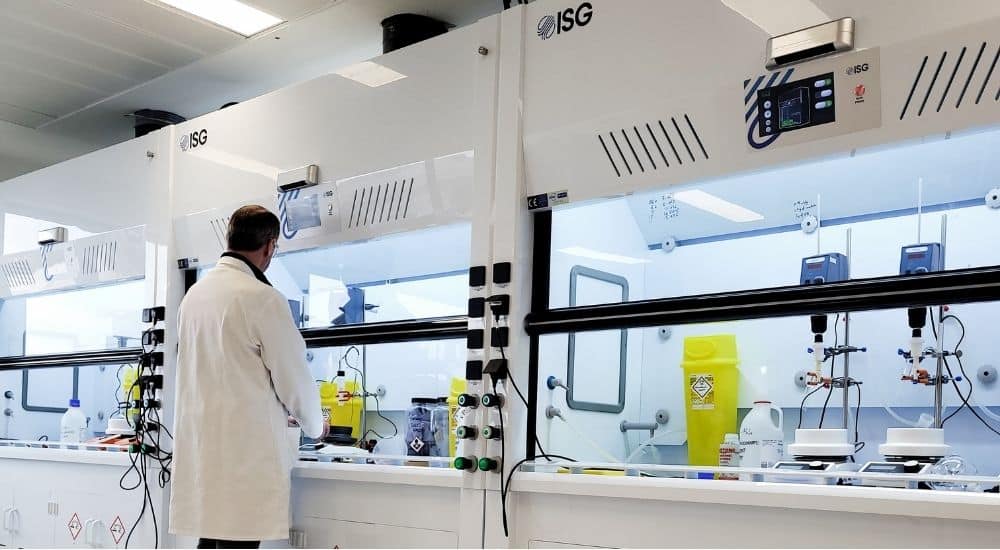
In its simplest form, the typical difference between a fume cupboard and a biosafety cabinet is the difference in hazard that is being protected against.
Fume cupboards (sometimes also known as fume hoods or fume closets) are mainly designed to protect users against harmful chemical vapours and gaseous materials. This can be organic compounds, acidic vapours, or a mixture of the above.
Biosafety Cabinets (or Microbiological Safety Cabinets) are designed to protect against microbiological hazards such as viruses and bacteria. There are three Microbiological safety cabinets classes: Class 1, Class 2 and Class 3. For clarity, we will focus only on Class 2 A2 cabinets in this article as it is the most popular and what is usually referred to when a user says 'Biosafety Cabinet'. We will also only focus on recirculating biosafety cabinets for the same reason as above.
Fume Cupboards
Fume cupboards are designed to draw air through the front of a sash opening at a consistent face velocity to ensure that any air inside the cabinet cannot escape towards the user and into the laboratory atmosphere.
The air is drawn through a duct to the outside and expelled into the atmosphere directly or through a filtration system.
Biosafety Cabinets (Class II)
Biosafety cabinet airflow differs significantly from that of a fume cupboard.
Class II cabinets have two directions of airflow. There is an inflow through a front sash (much like a fume cupboard) but also a laminar downflow from the top of the working chamber.
The air is drawn through the front sash of the biosafety cabinet and below a raised work surface before being passed up the back of the cabinet and through a double filter (typically HEPA H14 or ULPA in higher specification units). 70% of the air drawn into the cabinet is then passed back down through the filter in a laminar flow (smooth flow) onto the work surface. The remaining 30% of the air is expelled back into the room via another filter, which is continuous. The explanation for this pattern is explained later in this document.
Fume Cupboards
Fume cupboards are designed to protect only the user from what is inside the cabinet. Typically harmful chemicals and powders.
Biosafety Cabinets
Biosafety cabinets are designed to protect BOTH the user from the microbiological hazards inside the cabinet but ALSO the sample from any potentially cross contaminants that may be in the laboratory air. Remember that biosafety cabinets are designed to protect against biological hazards and are typically used in cell-based work. Any infections or bacteria carried into the lab via a technician could affect the results of the work being carried out if a biosafety cabinet didn't exist.
Fume Cupboards
The accepted European standard for Fume Cupboards is EN14175. This is used as the accepted standard for many countries worldwide if a relevant local standard is not available. In the USA, the standard is ASHRAE.
The certification process uses SF6 containment testing to ensure that no loss of containment happens during the working process. This is a type of test usually performed at the design stage of a new fume cupboard.
Fume cupboards are typically tested every 12 months, although the EN14175 standards dictate that fume cupboards should be tested every 14 months. This testing usually involves an airflow test to ensure that face velocities (and therefore containment) are being maintained, along with a number of other routine checks to ensure proper function.
Biosafety Cabinets
The standard for Biosafety Cabinets is EN12469 in the UK and Europe and NSF49 in the USA. As with Fume cupboards, these standards are used by many countries worldwide as their excepted standard. We will focus on EN12469 for today.
EN12469 dictates that two methods of testing are carried out. One for containment of the cabinet itself (i.e. is there any air escaping from the front of the sash) and a filter integrity test.
The accepted method for containment testing is KI-Discus testing.
The method for filter integrity testing is known as the DOP test or Dispersed Oil Particulate testing. This is used for testing HEPA filters in many applications, including cleanrooms, Laminar flow cabinets, Biosafety cabinets and power cabinets.
Biosafety cabinets should be tested using both of the above tests every 14 months, but in many cases, users will perform a DOP test on a more regular basis, such as every six months.
Along with the tests above, there are a number of other functions that should be tested on a regular basis to ensure the safety of users and samples.
Hopefully, it's clear to see the vast differences between these two cabinet types and why one should not be used for the other application.
In summary:
But, clearly, there are many more nuances around the detailed specification of each of these cabinet types which we can't cover in a single article.
However, if you have questions about what you might need we have a support team that is always on hand to assist you with any questions you many have.
Read our Privacy Policy for more information on how we collect and process data.



No thank you
Read our Privacy Policy for more information on how we collect and process data.